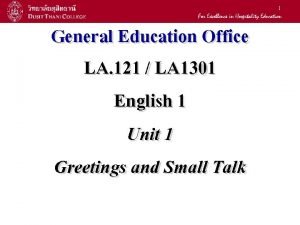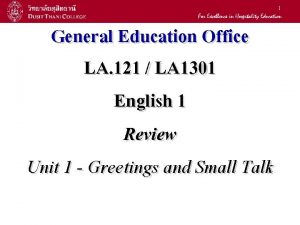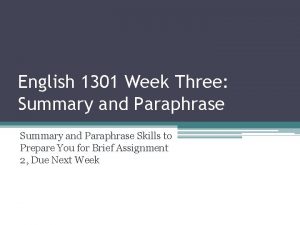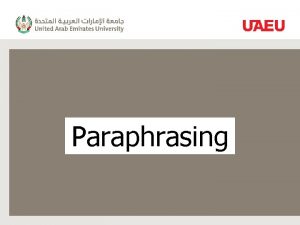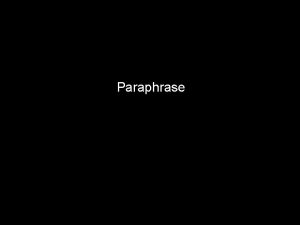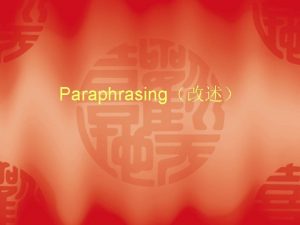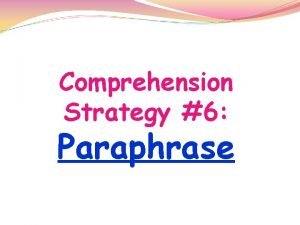ENGLISH 1301 DAY 3 Section 45 PARAPHRASE Paraphrase















- Slides: 15

ENGLISH 1301 DAY 3 Section 4/5

PARAPHRASE Paraphrase is… Restatement of an original text in YOUR OWN WORDS. It often concerns a particular passage or action (see the difference from summary) Do not change words sporadically (it is not a paraphrase!).

ORIGINAL PARAGRAPH The cause of autism has also been a matter of dispute. Its incidence is about one in a thousand, and it occurs throughout the world, its features remarkably consistent even in extremely different cultures. It is often not recognized in the first year of life, but tends to become obvious in the second or third year. Though Asperger regarded it as a biological defect of affective contact— innate, inborn, analogous to a physical or intellectual defect—Kanner tended to view it as a psychogenic disorder, a reflection of bad parenting, and most especially of a chillingly remote, often professional, "refrigerator mother. " At this time, autism was often regarded as "defensive" in nature, or confused with childhood schizophrenia. A whole generation of parents—mothers, particularly—were made to feel guilty for the autism of their children.

BAD EXAMPLE The cause of the condition autism has been disputed. It occurs in approximately one in a thousand children, and it exists in all parts of the world, its characteristics strikingly similar in vastly differing cultures. The condition is often noticeable in the child's first year, yet it becomes more apparent as the child reaches the ages of two or three. Although Asperger saw the condition as a biological defect of the emotions that was inborn and therefore similar to a physical defect, Kanner saw it as psychological in origin, as reflecting poor parenting and particularly a frigidly distant mother. During this period, autism was often seen as a defense mechanism, or it was misdiagnosed as childhood schizophrenia. An entire generation of mothers and fathers (but especially mothers) were made to feel responsible for their offspring's autism (Sacks 247 -48).

GOOD EXAMPLE In "An Anthropologist on Mars, " Sacks lists some of the known facts about autism. We know, for example, that the condition occurs in roughly one out of every thousand children. We also know that the characteristics of autism do not vary from one culture to the next. And we know that the condition is difficult to diagnose until the child has entered its second or third year of life. As Sacks points out, often a child who goes on to develop autism will still appear perfectly normal at the age of one (247). Sacks observes, however, that researchers have had a hard time agreeing on the causes of autism. He sketches the diametrically opposed positions of Asperger and Kanner. On the one hand, Asperger saw the condition as representing a constitutional defect in the child's ability to make meaningful emotional contact with the external world. On the other hand, Kanner regarded autism as a consequence of harmful childrearing practices. For many years confusion about this condition reigned. One unfortunate consequence of this confusion, Sacks suggests, was the burden of guilt imposed on so many parents for their child's condition (247 -448).

GOOD SUMMARY & BAD SUMMARY GOOD PARAPHRASE & BAD PARAPHRASE We will look at the two examples of summary & paraphrase. Which one do you think do a good job and explain why.

SUMMARY Summary A summary should "Include just enough information to recount the main points" of the article. It must include the subject of the article, the author's opinion on that subject (i. e. purpose) and his or her main supporting points (in other words, HOW an author argues).

MLA CITATION Whenever you summarize, paraphrase, quote someone’s work, You need to cite. MLA Citation format (see St Martin ch. 16 -b “In-text citations”) Paraphrase: at the end of the paragraph/sentence (author’s last name page number(s)). i. e. (Diamond 559)

MLA CITATION 2 You also need to have a “Work(s) Cited. ” See St Martin ch. 16 -d “SOURCE MAP: Articles in print periodicals” i. e. Diamond, Jerad. "The Ethnobiologist's Dilemma. " First-Year Writing: Writing in the Disciplines. 7 th ed. Boston: Pearson, 2013. 55662. Print. Note: Your bibliographical citation needs to inform where you read the piece, not where the article was published first.

RHETORICAL CHOICE

HOW RHETORICAL CHOICES WORK

RHETORICAL CHOICES IN DIAMOND’S ARTICLE To analyze his rhetorical choices, we need to establish two significant factors of the article. 1) Who is the intended audience? Where Who is the article published? is the author? What 2)What is the article about? is Diamond’s purpose?

RHETORICAL CHOICES Rhetorical choices always need to match with the purpose and audience to be effective. It is not what an author says; rather how s/he says. Please remember ethos, pathos, and logos are NOT rhetorical choices but effects.

RHETORICAL CHOICES (CONTINUED) Allusion Hyperbole Anecdote Statistics Formal/informal Illustration Jargon Maxim diction

WRITING CENTER

